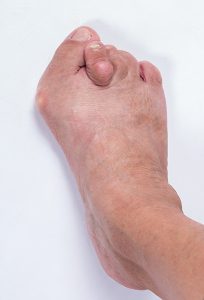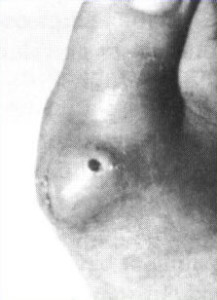Bunions
Bunions
“Bunion” is the lay term for a deformity known as hallux abducto-valgus, and refers to acondition where the big toe moves over the second and third toes, passing either over or under them, as shown in the picture to the right. This is a progressive condition, which may start in early childhood or in later life. The main problems bunions cause are in terms of shoe fitting, pressure problems (e.g. corns or sinuses on top of the joint – see picture below), arthritis in the joint itself, and because the first toe acts as a anchor for the rest of the forefoot, the other toes may take on clawed or hammered positions. Once a bunion starts to develop it will often continue as the tendons which control the first toe will become “bowstringed” and begin to pull the toe into a bunion position.
 Poorly Fitting Shoes – any shoes which are narrower around the ball of the foot or toes than the foot itself will force the first toe into a bunion position. Shoes responsible for this include court shoes, stilletoes, and any other type of slip on shoe (e.g. loafers and mules).
Poorly Fitting Shoes – any shoes which are narrower around the ball of the foot or toes than the foot itself will force the first toe into a bunion position. Shoes responsible for this include court shoes, stilletoes, and any other type of slip on shoe (e.g. loafers and mules).
Abnormal Biomechanics – people who flatten their feet to compensate for a biomechanical problem will change the direction that some of the tendons pull on the foot, again creating a tendency for the first toe to move out of position (see the Biomechanics & Orthotics page for an explanation of this!). If this is identified as a cause of bunions early in their development, treatment with orthotics will reduce the speed with which a bunion develops, and possibly stop it getting any worse.
 Ligamentous Laxity – in people whose tendons are very loose or double jointed, body appendages like toes will tend to move about in an uncontrolled manner and this makes it much easier for big toes to move into a bunion position. Orthotics as a preventative measure to limit bunion development are advisable in these cases
Ligamentous Laxity – in people whose tendons are very loose or double jointed, body appendages like toes will tend to move about in an uncontrolled manner and this makes it much easier for big toes to move into a bunion position. Orthotics as a preventative measure to limit bunion development are advisable in these cases
Treatment for bunions is varied and depends on the specific problems they cause. Some people may have bunions for years and never have any associated problems at all. Most conservative approaches to treatment centre around suitably roomy footwear, padding to reduce pressure over the joint, shoe stretching, and provision of orthotics to prevent the bunion worsening. Surgery can be helpful in some cases but as with any invasive procedure, it should be considered only as a last resort as the results are not always as expected.
